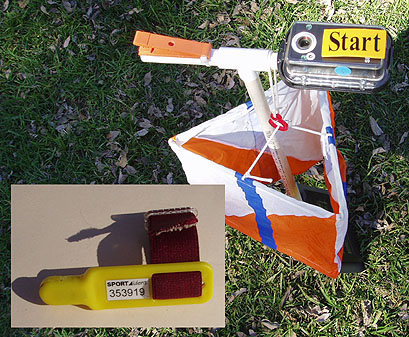
Excerpted and updated from my Homing In column in CQ-VHF Magazine for Summer 2004.

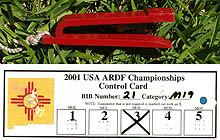 For decades, orienteering competitors proved that they visited their required controls by carrying a card that they mark with special punches at each one. Each punch has a unique pattern of perforating pins (photo at left). Radio-orienteers adopted the same system because the punches are inexpensive and durable. For informal practice sessions, they sometimes substituted colored pens or crayons.
For decades, orienteering competitors proved that they visited their required controls by carrying a card that they mark with special punches at each one. Each punch has a unique pattern of perforating pins (photo at left). Radio-orienteers adopted the same system because the punches are inexpensive and durable. For informal practice sessions, they sometimes substituted colored pens or crayons.
The pin-punch system worked well over the years, though it seemed that at least one runner lost the card on every hunt. In a local event, he or she would just punch the map and move on. However, the rules of national and international championships usually state that a lost card means disqualification. Another pin-punch problem is that occasionally a competitor will not squeeze punches firmly around the card, making it difficult or impossible to verify the correct pin pattern.
Classic orienteers moved into the 21st century by adopting an electronic scoring method usually referred to as "E-punch." The most popular system is SPORTident (SI). Here's how it works: Competitors wear a uniquely coded plastic tag called an "e-stick" or "dipstick." At the start line, finish line and at each fox found, they insert this tag into a SI control station (also called a transponder), which writes the location and exact time onto a chip in the tag using RFID technology (photo at top of page). After they "punch in" at the finish, they insert the e-stick into another control station at the scoring tent, where a laptop computer retrieves all the time data from the tag. The computer operator immediately prints out and gives the competitor a slip of paper with his or her overall elapsed time and splits (the elapsed time to find each fox).
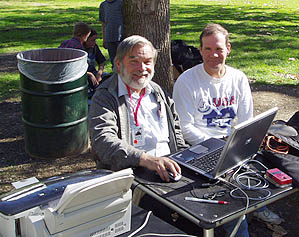 An early form of electronic scoring was used in the ARDF World Championships for the first time in 2000. SI scored the 2002 World Championships in Slovakia. Marvin Johnston KE6HTS (holding mouse in photo at left) liked it so much that he arranged for the use of Los Angeles Orienteering Club's SI gear for the 2004 USA Championships, for which he was Organizing Chair. It's also in regular use at southern California practice events.
An early form of electronic scoring was used in the ARDF World Championships for the first time in 2000. SI scored the 2002 World Championships in Slovakia. Marvin Johnston KE6HTS (holding mouse in photo at left) liked it so much that he arranged for the use of Los Angeles Orienteering Club's SI gear for the 2004 USA Championships, for which he was Organizing Chair. It's also in regular use at southern California practice events.
It takes a little longer for organizers to set up an e-punch hunt, but almost every competitor prefers it. Missing competitor cards are a thing of the past. E-sticks don't get lost because they are snugly attached to a finger with Velcro®. They don't get in the way and it's easy to punch in by making a fist and dipping it into the transponder. The results printout can reveal everyone's fox-finding order and times, so it's easy to see which routes were best and which foxes were most difficult.
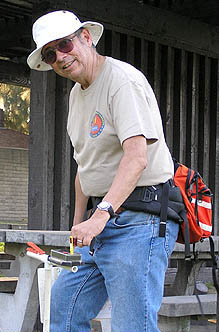 As I watched the 2004 championships, the only disadvantage I saw was the "pileup" at the start point. Two competitors in different age/gender categories left the start at each 5-minute interval, just as fox #1 came on the air. They had to take turns punching out just after the starting beep. Gentlemen usually let ladies punch first. World Championship organizers solve this by having several identical control stations available at start and finish.
As I watched the 2004 championships, the only disadvantage I saw was the "pileup" at the start point. Two competitors in different age/gender categories left the start at each 5-minute interval, just as fox #1 came on the air. They had to take turns punching out just after the starting beep. Gentlemen usually let ladies punch first. World Championship organizers solve this by having several identical control stations available at start and finish.
SI computer software is easily programmed for a variety of orienteering and ARDF events. A typical foxhunt is scored like a "Score-O" in orienteering, with each fox worth one point. The software verifies that competitors punch the correct foxes for their categories and that they do not punch extraneous foxes.
Timing information remains in transponder memory as well as tag memory. If a competitor gets lost or doesn't come to the finish for some reason, the organizers can get data from the transponders regarding which foxes the runner has already visited and when, as an aid in searching.
E-punch is another good reason for ARDF fans to get together with their local orienteering clubs. LAOC has been very cooperative in providing the complete system for local and championship ARDF events. Orienteering clubs usually charge $2 or so per event for e-stick rental. This helps cover the cost of the equipment. Regular competitors buy and keep their own stick to avoid the rental fees.
Here are three stateside suppliers of e-sticks:
Your e-stick may be reused thousands of times. Special control stations for clearing your stick and checking it are provided at the start of each event. There is no battery inside -- power comes from the control station when writing or clearing the internal chip.
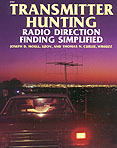 Go to International-Style Foxhunting Comes To The Americas -- How we're getting the ball rolling
Go to International-Style Foxhunting Comes To The Americas -- How we're getting the ball rolling
Go to Equipment Ideas for Radio-Orienteering -- Simple and inexpensive receiving and transmitting solutions
Go to Latest Championship Foxhunting News -- Stories of recent national and international ARDF events and announcements of upcoming ones
Go to Foxhunting for Scouts -- Let's get the kids involved
Go to Try ARDF on 80 Meters. -- The "other" foxhunting band
Go to Extenders Aid Handicapped Foxhunters -- A novel way to include persons with disabilities
 Back to the Homing In home page
Back to the Homing In home page
This page updated 5 July 2025